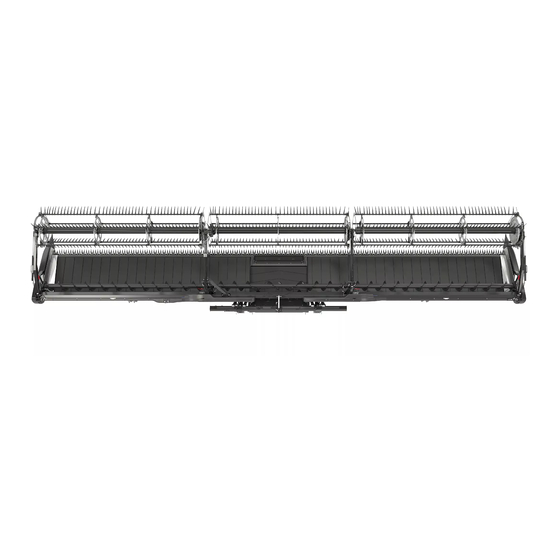
MacDon FlexDraper FD2 Series Manual
Hide thumbs
Also See for FlexDraper FD2 Series:
- Operator's manual (566 pages) ,
- Manual (560 pages) ,
- Installation instructions manual (60 pages)
Advertisement
Quick Links
Recommended Fluids and Lubricants
Ensure your machine operates at top efficiency by using clean fluids and lubricants only.
•
Use clean containers to handle all fluids and lubricants.
•
Store fluids and lubricants in an area protected from dust, moisture, and other contaminants.
Lubricant
Specification
High temperature extreme
pressure (EP) performance
grease with 1% max
molybdenum disulphide
(NLGI Grade 2) lithium base
Grease
SAE multi-purpose
High temperature extreme
pressure (EP) performance
grease with 10% max
molybdenum disulphide
(NLGI Grade 2) lithium base
Gear Lubricant SAE 85W-140
API service class GL-5
Single grade trans-hydraulic oil
Viscosity at 60.1 cST @ 40°C
Viscosity at 9.5 cST @ 100°C
Recommended brands:
Hydraulic Oil
Lubricant trans / hydraulic oil
•
Petro-Canada Duratran
•
John Deere Hy-Gard J20C
•
Case Hy-Tran Ultraction
•
AGCO Power Fluid 821 XL
Viscosity of 100–150 sCt at 40°C
Formulated for wear protection
Chain Oil
(104°F) or mineral oil SAE 20W-
and resistance to foaming.
To help avoid major component service or replacement, perform break-in inspections on your machine for the first 50 hours of
operation. Refer to your operator's manual for complete break-in inspection and adjustment procedures.
Interval
First 5 Minutes
Check hydraulic oil level in reservoir (check after first run-up and after the hydraulic hoses have filled with oil).
5 Hours
Check for loose hardware and tighten to required torque.
Check auger drive chain tension.
10 Hours
Check knife drive box mounting bolts.
Grease feed draper drive roller and idler roller bearings.
Change float module gearbox oil.
50 Hours
Change knife drive box lubricant.
Lubricate reel drive chain.
Ongoing Maintenance Intervals
Refer to the operator's manual for a comprehensive maintenance schedule and record. Log hours of operation, use the maintenance
record, and keep copies of your maintenance records.
Following the maintenance schedule will increase your machine's life.
Description
Use
As required unless
otherwise specified
Driveline slip-joints
Knife drive box
Main gearbox
Completion gearbox
Header drive systems
reservoir
Reel drive chain
Break-In Inspections
Item
Change float module hydraulic oil filter.
Check gearbox chain tension.
Capacities
Follow these five steps in order to set the header float and wing balance:
NOTE:
Read and understand the header float section of your operator's manual before setting header float.
—
a.
Park the combine on a level surface, and ensure the combine feeder
house is level. Use the bubble level on the float module.
—
b. Adjust the header so the cutterbar is 250 mm (10 in.) (A) off the
ground.
c.
Set the header angle hydraulic cylinder to D on indicator (B).
1.5 liters (1.3 quarts)
d. Set the reel fore-aft to 6 on reel arm fore-aft indicator (C).
2.75 liters (2.9 quarts)
e.
Lower the reel completely, shut down the combine, and remove the
key from the combine ignition.
2.25 liters (2.4 quarts)
95 liters
(25.1 US gallons)
f.
Remove linkage cover (A).
g.
Place both left and right wing lock spring handles (B) in the locked
(upper) position. You should hear the locks engage. If not, move the
—
wings up and down, so that the locks engage.
h. Place both the left and right header float locks in unlocked (lowered)
position (A).
i.
Set the stabilizer/transport wheels or contour wheels (if equipped) to
the upper most position.
Subject to change without notice
SETTING HEADER FLOAT AND WING BALANCE
Step 1: Preadjustments
Figure 1: Header – Side View
Figure 2: Wing Lock Spring Handle in Locked Position – Left
Side Shown
Figure 3: Float Unlocked – Left Side Shown
Advertisement

Summary of Contents for MacDon FlexDraper FD2 Series
- Page 1 Recommended Fluids and Lubricants Ensure your machine operates at top efficiency by using clean fluids and lubricants only. • Use clean containers to handle all fluids and lubricants. • Store fluids and lubricants in an area protected from dust, moisture, and other contaminants. SETTING HEADER FLOAT AND WING BALANCE Lubricant Specification...
- Page 2 Recheck the wing balance. Adjust as required until the wing is balanced available adjustments, an optional heavy duty spring is available. See (Condition C). your MacDon Dealer or refer to the parts catalog for ordering d. Move the spring handle to the upper (LOCK) position. information.














Need help?
Do you have a question about the FlexDraper FD2 Series and is the answer not in the manual?
Questions and answers